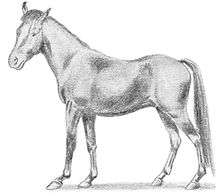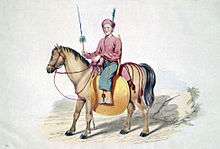Manipuri Pony
The Manipuri Pony is a traditional Indian breed of small horse or pony from Assam and Manipur in north-eastern India. It appears both in the history and the mythology of Manipur, and was used for warfare. It is believed to have been the polo pony in use in Assam in the mid-nineteenth century when British tea planters first saw polo being played, and the height limits set for polo ponies were based on ponies of this breed. It was very numerous in the early twentieth century, but numbers have since fallen. A breed society was established in 1977, and a breed standard was drawn up by the Indigenous Horse Society of India in 2009.[4]:484
 | |
| Conservation status | |
|---|---|
| Other names |
|
| Country of origin | India |
| Distribution | |
| Standard | Indigenous Horse Society of India |
| Traits | |
| Height |
|
| Colour | fourteen recognised colours[4]:484 |

History
Small horses have been bred for centuries in the Manipuri area of north-eastern India.[5] They were often used as warhorses, and were ridden by the Meitei warriors of Kangleipak (later called Manipur). Horses from Manipur were used by the cavalry of Gharib Newaz in his wars against the Konbaung dynasty of Burma.[6] When the game of polo was first observed by British tea planters in Assam, these are believed to have been the polo ponies that were being used.[4]:484 Some unsuccessful attempts were made to cross-breed the Manipuri polo ponies with Arab stock.[4]:484 The height of polo ponies was based on the average height of the Manipuri, and was at first restricted to 132 cm (13 hands), later relaxed to 136 cm (13 h); in 1916 the restriction was completely removed.[4]:484 At about this time the export of ponies from Manipur was banned in order to allow breed numbers to recover.[6] Manipuri horses were used to transport British troops into Burma during the Second World War.[7]
In 1977 a breed society, the Manipur Horse Riding and Polo Association, was established.[8] In recent years, breed numbers have decreased, and estimates place the breed at somewhere between 2300[5] and 1000 in population in the 21st century.[7] Population numbers continue to dwindle in part due to high numbers of ponies being smuggled into Myanmar (Burma), where the breed is in demand, after either having been purchased or stolen from their Indian owners. In 2005, a heritage park was opened by the Manipur Horse Riding and Polo Association with the goal of preventing the extinction of the breed and promoting them to tourists.[7]
Characteristics
The Manipuri Pony has a light head with a straight profile, set on a well-formed neck, somewhat pronounced withers, a deep chest and sloping shoulders. The croup is sloping, the legs sturdy and the hooves well-proportioned. The overall appearance is elegant. Manipuri ponies generally stand 11 to 13 hands (44 to 52 inches, 112 to 132 cm) high.[9] They are often bay in color, but can also be pinto, grey and chestnut.[10] Because of the short height of the ponies, riders use shortened mallets while playing polo.[11] The Manipuri pony resembles, and is distantly related to, the Burmese Pony and the Indonesian Batak and Sumba ponies.[6]
In 2007, a study was published that examined genetic variation among five Indian equine breeds—the Manipuri, Marwari, Spiti, Bhutia, and Zanskari. Based on analysis of microsatellite DNA, the Manipuri was found to have the greatest genetic distance from the Marwari, and a much closer genetic distance to the other three breeds.[12] The distance from the Marwari was not only genetic, but seen in physical characteristics, particularly height and environmental adaptability. The physical differences were attributed to differing ancestries: the Marwari horse is closely associated with the Arabian, while the four other breeds are thought to have descended at least in part from the Tibetan pony. None of the breeds in the study were found to be closely genetically associated with the Thoroughbred.[12]
Uses
Polo was introduced into the area of Manipur state as early as the seventh century, and Manipuri ponies were one of the first breeds used in the game.[10] The British learned of polo during the nineteenth century while watching it played on Manipuri ponies in India. The breed is still used for polo today in India, but other breeds are more popular in Europe and America.[9] Manipuri ponies are often also used to play sagol kangjei, a version of polo believed to be close to what was originally played when the sport was invented. Sagol kangjei is more demanding than modern polo, as ponies are used for the entire match instead of being changed between periods.[13] Manipuri ponies are also used for racing.[5] During their early history, they were in demand as cavalry horses, and men that rode these ponies were thought well-mounted.[10]
References
| Wikimedia Commons has media related to Manipuri. |
- Barbara Rischkowsky, D. Pilling (eds.) (2007). List of breeds documented in the Global Databank for Animal Genetic Resources, annex to The State of the World's Animal Genetic Resources for Food and Agriculture. Rome: Food and Agriculture Organization of the United Nations. ISBN 9789251057629. Accessed January 2017.
- Breed data sheet: Manipuri Pony / India (Horse). Domestic Animal Diversity Information System of the Food and Agriculture Organization of the United Nations. Accessed January 2020.
- Manipuri Pony Breed Standard. Indigenous Horse Society of India. Accessed January 2020.
- Valerie Porter, Lawrence Alderson, Stephen J.G. Hall, D. Phillip Sponenberg (2016). Mason's World Encyclopedia of Livestock Breeds and Breeding (sixth edition). Wallingford: CABI. ISBN 9781780647944.
- "Equines in India". National Research Centre On Equines (Indian Council on Agricultural Research). Archived from the original on 25 May 2010. Retrieved 27 February 2008.
- "Manipuri Pony Breed Standard". Indigenous Horse Society of India. Archived from the original on 22 May 2011. Retrieved 4 April 2011.
- "Park boon for Manipur pony - Polo association to build heritage hub to try and save dying species". The Telegraph. 29 December 2008. Archived from the original on 26 October 2012. Retrieved 4 April 2011.
- "A ride through the changes in modern Polo". The Economic Times. 5 December 2010. Archived from the original on 17 October 2012. Retrieved 31 March 2011.
- Bongianni, Maurizio (editor) (1988). Simon & Schuster's Guide to Horses and Ponies. New York, NY: Simon & Schuster, Inc. p. Entry 120. ISBN 0671660683.CS1 maint: extra text: authors list (link)
- Hendricks, Bonnie (2007). International Encyclopedia of Horse Breeds. University of Oklahoma Press. ISBN 9780806138848.
- Edwards, Elwyn Hartley (1994). The Encyclopedia of the Horse (1st American ed.). New York, NY: Dorling Kindersley. p. 201. ISBN 1564586146.
- Behl, R.; Behl, J.; Gupta, N.; Gupta, S.C. (May 2007). "Genetic relationships of five Indian horse breeds using microsatellite markers". Animal. 1 (04): 483–488. doi:10.1017/S1751731107694178. PMID 22444405.
- Chowdhury, Fatima (11 February 2011). "The Gods of Polo". The Southasia Trust. Archived from the original on 11 November 2011. Retrieved 9 December 2011.